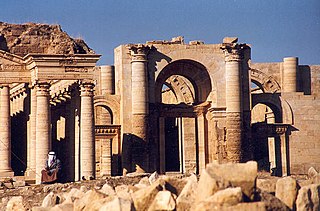Kingdom of Hatra
2nd-century Arab kingdom From Wikipedia, the free encyclopedia
The Kingdom of Hatra,also called Kingdom of Arabaya[1] and Araba.[2] was a 2nd-century Arab kingdom located between the Roman Empire and the Parthian Empire, mostly under Parthian suzerainty,[3][4] in modern-day northern Iraq.
Kingdom of Hatra | |||||||||
|---|---|---|---|---|---|---|---|---|---|
| 2nd century CE–241 | |||||||||
 Approximate map of the kingdom of Hatra (green) and other Parthian Mesopotamian vassal kingdoms in AD 200 | |||||||||
| Status | Autonomous state, frequently a vassal of the Parthian Empire | ||||||||
| Capital | Hatra | ||||||||
| Common languages | Hatran Aramaic Old Arabic | ||||||||
| Religion | |||||||||
| Government | Monarchy | ||||||||
| King | |||||||||
| History | |||||||||
• Established | 2nd century CE | ||||||||
• Fall of Hatra | 241 | ||||||||
| |||||||||
| Today part of | Iraq | ||||||||
Name
The name of "Hatra" appears various times in the Aramaic Hatrene inscriptions as 𐣧𐣨𐣣𐣠 (ḥṭrʾ, vocalized as: Ḥaṭrāʾ), probably meaning "enclosure, hedge, fence".[4]
History
Summarize
Perspective
The history of Hatra before the Parthian Empire is obscure. It has been suggested that a settlement was founded there under the Neo-Assyrian Empire or the Achaemenid Empire, but that remains speculative.[4] The earliest known records that mention Hatra are from the late 1st-century.[5] The early rulers of Hatra used the title of marya "lord", but starting from the 170s, they started using the title of malka "king", often in the form of "King of the Arabs".[6][7] This elevation of titulature is considered to be related to the Roman incorporation of Edessa in 165, which resulted in Hatra being the westernmost part of the Parthian Empire, and thus of higher strategic importance.[8]
In the first and second century, Hatra was ruled by a dynasty of Arab princes. It rose to prominence as the capital of Hatra and became an important religious center as a result of its strategic position along caravan trade routes. Hatra is one of the first Arab states to be established outside of the Arabian Peninsula, preceded by Osroene (132 BC–216 AD) and the Kingdom of Emesa (64 BCE–300s CE), and followed by the Ghassanids (220–638) and the Lakhmids (300–602), buffer states of the Roman and Sasanian Empires, respectively.
Hatra had withstood sieges by Roman emperors Trajan and Septimius Severus and the Sasanian king Ardashir I. The kingdom finally fell after the Fall of Hatra to the Sasanians under Shapur I, who destroyed the city.[9]

Culture
Summarize
Perspective
Hatra was part of the Parthian commonwealth, a term used by historians to refer to cultures that were under Parthian control, but mainly populated by non-Iranians.[10] Although the Hatran language and its cults were very similar to that of the rest of Aramaic-speaking world in Mesopotamia and Syria, the Parthian Empire had heavily influenced the culture and political system of Hatra, as attested by epigraphic and archaeological findings.[11]
Many Parthian titles are known to have been used, many which were also used in slightly different variants in Armenia as well as some in Parthia. This includes titles such as naxwadār (also attested in Armenian as naxarar), which was seemingly used as a personal name in Hatra. Other titles include pasāgrīw (heir-apparent), bitaxs (possibly viceroy), asppat (head of cavalry), ašpazkan (chamberlain), hadarpat (possibly chiliarch), naxširpat (chief of the hunt), and dahicpat, a word used as an epithet of the god Nergol. Not all the titles are solely Parthian, as some of the seem to have been derived from Old Persian. Regardless, these titles are attested in all the western parts of the Parthian Empire, which indicates that the Hatran court was shaped to imitate that of the Parthian royal court.[12]
Like the rest of the Parthian commonwealth, Iranian personal names are also well attested in Hatra. The ruling family adopted the same names used by the Arsacid kings, such as Worod, Walagash and Sanatruq. The local populace also dressed in Parthian clothing, used Parthian jewellery and bore Parthian weapons.[13]
Various gods were honored in the kingdom, including those of Sumero-Akkadian, Greek, Aramean, and Arabian religions.[2]
List of rulers
| Name | Title | Date | Portrait | Note | |
|---|---|---|---|---|---|
| 1 | Worod | mry´ | |||
| 2 | Ma’nu | mry´ | |||
| 3 | Elkud | mry´ | 155/156 | ||
| 4 | Nashrihab | mry´ | 128/29 - 137/38 AD | ||
| 5 | Naṣru | mry´ | 128/29 - 176/77 | ||
| 6 | Wolgash I | mry´ and mlk | |||
| 7 | Sanatruq I | mry´ and mlk | 176/177 | Ruled together with Wolgash I | |
| 8 | Wolgash II | ||||
| 9 | Abdsamiya | mlk | 192/93 - 201/202 | Supported the Roman emperor Pescennius Niger | |
| 10 | Sanatruq II | mlk | 207/08 - 229/230 | Became a vassal of the Romans under Gordian III during Roman-Persian Wars | |
See also
- Arbayistan (Arbaya), the Sasanian province
References
Sources
Wikiwand - on
Seamless Wikipedia browsing. On steroids.
